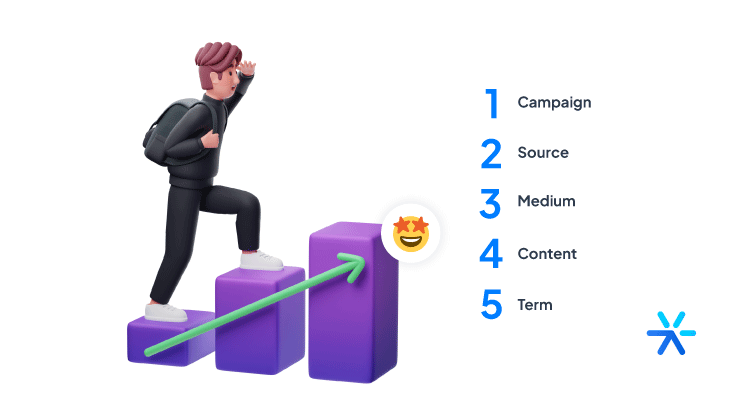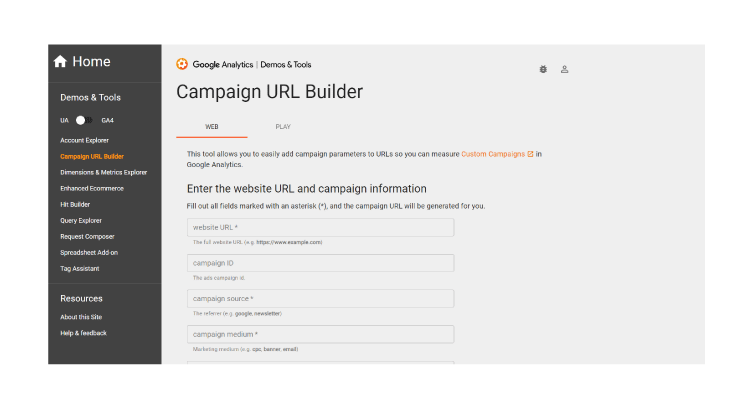UTM: Learn What It Is, How It Works, and Its Parameters
Let’s talk about another one of the dozens of acronyms that exist in digital marketing. This time, we’ll explore UTM parameters.
In summary, without giving away too much, it’s through UTM parameters that you can track your website traffic.
Well, just with this information, we can already perceive the importance of this topic. Nevertheless, UTM is still not as commonly used by marketing professionals due to its level of difficulty.
However, rest assured, I’ll address this subject in the most objective and comprehensive way possible.
Keep reading to clear all your doubts!
What is UTM?

Urchin Traffic Monitor, or simply UTM, is a set of parameters responsible for tracking visits to a specific page, through codes added at the end of a URL.
In other words, with UTM parameters, you’ll be able to analyze where the visitor came from, helping the company understand user behavior, and evaluate which channels are yielding the most results for your website.
How Does UTMs Work?
For UTM to work, you need to have the URL of the user’s destination page at hand. Next, you’ll need to add “?” and the UTM parameters to the URL, which we’ll explain shortly – this is the code we mentioned in the previous topic.
With the complete link ready, it’s time to decide where to place it, such as on social networks, email, blog, ads, etc.
There you go, with your link ready and well-placed, you’ll be able to analyze your website traffic through Google Analytics!
Do You Understand the Importance of Using UTMs in Digital Marketing?

By analyzing UTMs and discovering where your users came from, you can make more assertive decisions regarding your marketing strategies. It also helps you niche down even further on the channels that bring results to your business.
Now let’s delve deeper into the advantages and disadvantages of using UTMs in Digital Marketing.
Tracking traffic sources
Want to know which channel is bringing the most traffic to your site? Well, UTM allows you to analyze that.
From there, you can think about strategies targeted to that media.
Read also: 5 Best Lead Generation Channels for Small Businesses
Track your campaigns
If you’re wondering how much result your new campaign will bring to your site, UTM is also there for that.
You just need to add the campaign name to the UTM for all links and ads in that promotion.
Read also: What is a Dashboard and How to Create a Panel to Demonstrate Your Team’s Results
Ad Optimization
To improve the performance of your ads, you can use A/B tests with UTMs.
Just add a different parameter for each of the tested images and, in the end, find out which format had the best result.
Read also: Discover the Importance of A/B Testing to Increase Results
You get to know your customer
By analyzing where your visitor comes from, you can understand more about their search habits and interests. In other words, your company has the chance to know them better and provide a more personalized experience.
Investment savings
When you discover what works for your business, be it in strategies, ads, content, or types of channels, you focus more on what is yielding results. Thus, your investment in other alternatives decreases since they are not bringing as much return.
Increased profitability for your businesses
The more information you have about your customer, the more personalized the experience will be, and consequently, the audience will be more satisfied, increasing your chances of making a sale.
Besides this aspect, with the reduction of investments in strategies that do not bring returns, your results also tend to improve.

What Are UTM Parameters?

UTM parameters are the variables used to track your website traffic. Therefore, it’s important to understand each of them.
Let’s go!
Campaign
This parameter is used to identify the name of the marketing campaign.
UTM campaign is typically used if there’s a strategic campaign, specific product on promotion, important keyword, among others.
Example:
leadster.com/blog/utm_source=instagram&utm_medium=post&utm_content=home&utm_campaign=black_fridayNote: this parameter is mandatory.
Source
In UTM Source, you need to insert the traffic source. In other words, you need to inform where your campaign will be displayed.
You can put the name of the social network, blog, email, pop-up, etc.
Example:
leadster.com/blog/utm_source=instagram&utm_medium=post&utm_content=home&utm_campaign=black_fridayNote: this parameter is mandatory.
Medium
In UTM Medium parameter, you need to specify the medium or location where the link was shared.
You indicate through which media people will reach your page, such as CPC, email, banner, social media, display, e-book, among others.
Example: leadster.com/blog/utm_source=instagram&utm_medium=post&utm_content=home&utm_campaign=black_fridayNote: this parameter is mandatory.
Content
UTM content is an optional parameter, used when it’s necessary to identify a particular campaign or when conducting A/B tests.
Example: leadster.com/blog/?utm_source=instagram&utm_medium=post&utm_content=testea&utm_campaign=black_fridayTerm
This optional parameter is used to identify the keyword used in the campaign. UTM term is widely used in Google Ads.
Example: leadster.com/blog/?utm_source=google&utm_medium=cpc&utm_campaign=black_friday&utm_term=chatbot_para_geracao_de_leadsWhere to Use UTM Parameters?

Now that you know what UTM parameters are and their importance, let’s talk about the channels where this strategy can be applied!
Social Media
In addition to discovering which social networks are bringing more traffic, through UTM, you can also analyze which of the posted links are engaging the audience more.
Read also: Facebook Pixel: What Is It For and How to Set It Up on the Website?
Ads
Paid media ads can also be monitored through UTMs. Based on the defined parameters, you can measure the performance of your ads.
This analysis applies to any format, from images and banners to sponsored links.
Partnerships
The partnerships you establish, such as sponsored posts, guest content, and banners, images, and partner links can also have their traffic tracked by UTM.
You know the links you include in your emails? Well, they can also be tracked by UTM parameters.
This way, you can check how the clicks in the sent emails are performing.
Create a UTM Code in 6 Easy Steps
To assist you in creating the perfect UTM for your business, here are 6 steps to pay attention to:
Define where to use UTM codes
Before you start creating your UTM code, define where the link will be placed, as this is an essential variable for the strategy.
In other words, your link will be applied on social media, in ads, in marketing emails, etc.
Understand how UTM parameters work
Have you understood what UTM parameters are and how they work as explained here? Because it will be based on them that your traffic analysis will be done.
Familiarize yourself with UTM code variables
Do you already know which variables you will use in your UTM code? Remember that some of them are mandatory, while others are seen as complements – but I advise using all of them to provide a more comprehensive analysis.
Time to create UTM codes
For this step, you have two options:
Create the UTM code manually. Writing the complete code manually;
Create the code using a UTM generator. In this case, you just need to fill in all the variables that appear in the tool, called URL Builders. You can use Google’s UTM Generator for free on this link.

Read also: How to Use Google Analytics to Generate More Conversions on Your Site
URL Shortener
I know, the size of this URL became huge and not pleasant to see. And be aware that besides not being pretty, having large URLs is not recommended as a good marketing practice. The shorter and simpler the URL, the better.
Don’t worry, there is a solution for that!
Use tools like bitly, which will help shorten the length of your URL.
Measure your success and use data to improve
Remember: what is not measured cannot be improved.
Therefore, as soon as your UTM is working, start analyzing your results. After all, that’s why you invested in this strategy. Find out how your site’s traffic is being generated, what areas need improvement, and also what’s working well.
We’ve come to the end of another strategic content!
You see, UTM parameters are not difficult, they are just misunderstood because they require a little more attention.
You know what’s also a little bit like that? Lead generation. People think it’s hard but really it’s just a matter of instaling a simple chatbot on your website.
Don’t believe me? That’s ok: see for yourself. Try out Leadster today for free, no credit card required. You WILL see your results improving in just a couple of days.
Thank you for reading. See you on the free trial!








